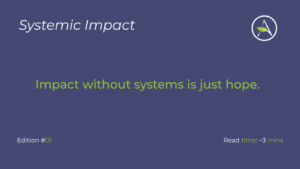
Impact Without Systems Is Just Hope
Impact Without Systems Is Just Hope. Read time: 3 mins Systemic Impact is brought to you by: Sustain Global Where purpose-led founders grow together. Sustain Global hosts one of the

Impact Without Systems Is Just Hope. Read time: 3 mins Systemic Impact is brought to you by: Sustain Global Where purpose-led founders grow together. Sustain Global hosts one of the

Photo by Lay Low In the world of business, the first customer is typically someone who purchases your product or service, hoping it will benefit them, regardless of its value.

Photo by Karolina Grabowska In the realm of business growth, investing in your value chain serves as a cornerstone of success, surpassing the traditional focus on expanding your workforce. Just

Photo by Peng Louis Read time: 3 minutes After the term ‘global warming’ changed to ‘global boiling,’ as a purpose-driven business, everyone at Anima felt incredibly frustrated. Shaken to our core, being in the

Photo by Pixabay Read time: 4 minutes As purpose entrepreneurs, our core belief lies in driving system change. But what exactly is system change? It’s all about transforming those widely accepted social

Photo by George Becker Read time: 4 minutes Negotiating with corporates can often be an uncomfortable task, especially for purpose entrepreneurs. Many struggle with leading negotiations and effectively communicating the value of

Read time: ~5 minutes Executive Summary: Establish a defined flow for discussions: Instead of relying on a memorized script, follow a consistent process that allows for natural and authentic conversations, similar to painting

Weekly editions of unbiased perspectives that can help navigate industry challenges